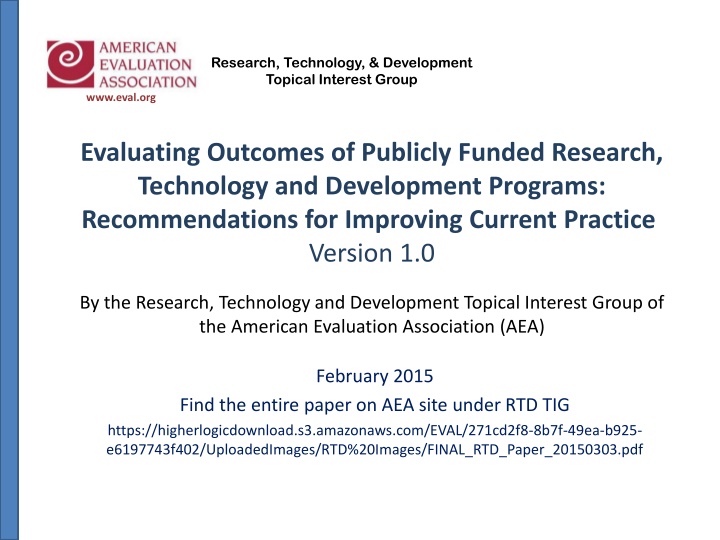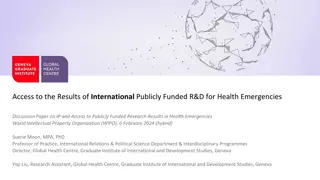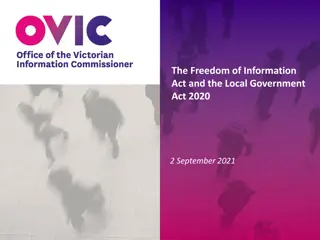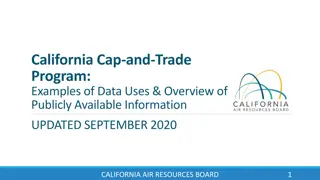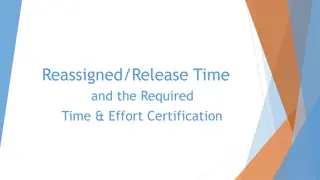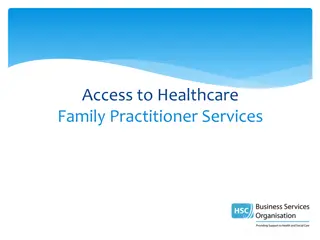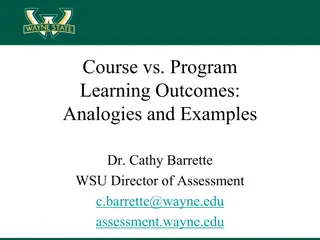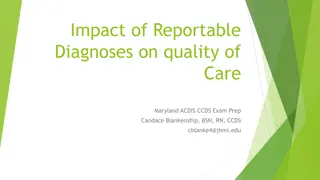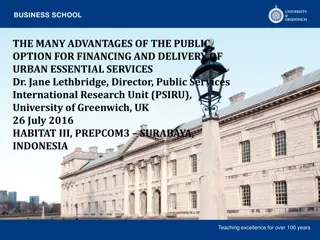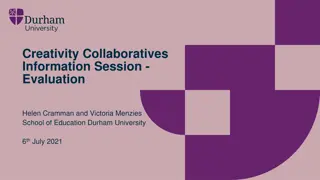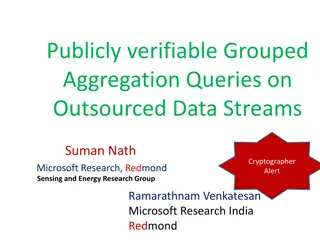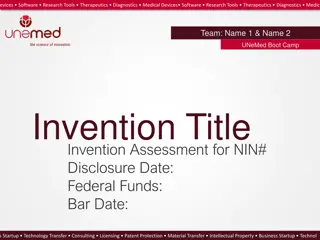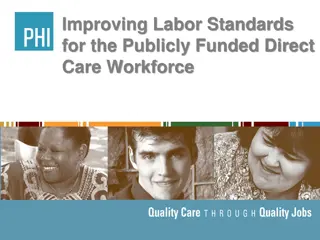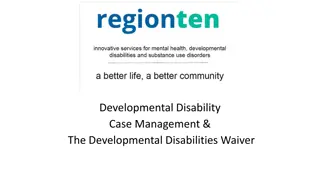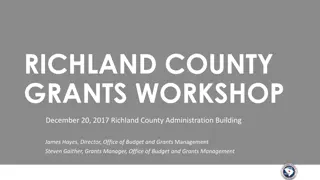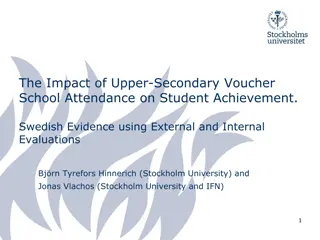Evaluating Outcomes of Publicly Funded Research, Technology, and Development Programs
This paper by the RTD TIG of the American Evaluation Association outlines recommendations for improving the evaluation practices of publicly funded research, technology, and development programs. It emphasizes the need for a common evaluation language and practice to address the diversity in RTD programs and ensure meaningful outcomes assessment. The scope encompasses all aspects of publicly funded programs, including research, technology, development, and deployment.
Uploaded on Mar 13, 2025 | 0 Views
Download Presentation

Please find below an Image/Link to download the presentation.
The content on the website is provided AS IS for your information and personal use only. It may not be sold, licensed, or shared on other websites without obtaining consent from the author.If you encounter any issues during the download, it is possible that the publisher has removed the file from their server.
You are allowed to download the files provided on this website for personal or commercial use, subject to the condition that they are used lawfully. All files are the property of their respective owners.
The content on the website is provided AS IS for your information and personal use only. It may not be sold, licensed, or shared on other websites without obtaining consent from the author.
E N D
Presentation Transcript
Research, Technology, & Development Topical Interest Group www.eval.org Evaluating Outcomes of Publicly Funded Research, Technology and Development Programs: Recommendations for Improving Current Practice Version 1.0 By the Research, Technology and Development Topical Interest Group of the American Evaluation Association (AEA) February 2015 Find the entire paper on AEA site under RTD TIG https://higherlogicdownload.s3.amazonaws.com/EVAL/271cd2f8-8b7f-49ea-b925- e6197743f402/UploadedImages/RTD%20Images/FINAL_RTD_Paper_20150303.pdf
Presentation of the RTD TIG Paper Outline Purpose, scope Evaluation context Recommendations: Evaluation planning Recommendations: Methods Recommendations: Common framework Proposed logic and indicators Summary, next steps Version 1.0, AEA RTD group February 2015 2
Purpose, Approach The purpose of this paper is engage RTD evaluators, program managers, and policy makers in a dialogue about a current RTD evaluation practice and how it might be improved. The end goal is consensus on a common RTD evaluation language and practice that is then broadly implemented. This is needed because the diversity in RTD programs leads to evaluation without enough consideration of context. Approached through Review of US government, national academy guidance and other literature, Our years of practical experience,and Expert review (written and in workshops) Version 1.0, AEA RTD group February 2015 3
Scope is Broad But Not Comprehensive Publicly funded Program level All aspects: research, technology, development and deployment Including innovation, defined as a new product, process or organizational practice that is entering the market Outcomes before, during and after (life cycle) Program contribution to outcomes Purpose: both accountability and learning Version 1.0, AEA RTD group February 2015 4
Relationship to AEA Evaluation Roadmap for Effective Government While we endorse all of the 17 recommendations, we singled out two of them to expand upon for RTD programs: 1. Build into each new program and major policy initiative an appropriate evaluation framework to guide the program or initiative throughout its life. 2. Promote the use and further development of appropriate methods for designing programs and policies, monitoring program performance, improving program, operations, and assessing program effectiveness and cost. A third area of emphasis was added as the paper evolved: The RTD community should move toward the utilization of agreed upon evaluation frameworks tailored to the RTD program type and context in order to learn from synthesis of findings across evaluations. Version 1.0, AEA RTD group February 2015 5
Current Context for RTD Evaluation in U.S. GPRA Modernization Act of 2010 (GPRAMA 2010), Office of Management and Budget (OMB) Circular A-11, and OMB/OSTP Annual Memo on Budget Priorities require performance planning, measurement and evaluation; see evaluation as an important tool GPRAMA has increased emphasis on cross-organization collaboration and government-wide priority setting. White House Office of Management and Budget (OMB) has similar requirements and values evaluation Annual budget guidance in Circular A-11 Specific guidance in annual budget priorities memo sent jointly with the Office of Science and Technology Policy Version 1.0, AEA RTD group February 2015 6
Context: Data and Other Challenges Unpredictable nature and timing of research progress, extended period of time between research outcomes, involves multiple actors who build on each other s work, Programs have to meet requirements while building a measurement system Permission to access data can be difficult Data quality is essential and often requires considerable effort Data quality also depends on the context in which it is applied (fitness for use) Errors can happen when big data is collected, structured and analyzed without enough information (or program theory) Both the questions evaluators are asked to study and the interpretations and uses of findings concerning program effectiveness and/or efficiency are political/policy matters Version 1.0, AEA RTD group February 2015 7
Context: challenge of looking across evaluation studies to draw broad conclusions Apparent contradictions between the conclusions of various studies due to differences in study design such as types of innovations studied and timeframes considered; Biases in the selection of cases to examine in research; A lack of clarity and unity in the definitions of explored concepts (across studies), such as discovery, invention and innovation; Unclear descriptions of study methodology and techniques for data collection and analysis with associated difficulties in the ability to repeat them; The challenge of setting boundaries in research for data collection and analysis, including defining the starting and finishing lines; Challenges in impact attribution; and Issues of sector idiosyncrasies with respect to innovation processes. Version 1.0, AEA RTD group February 2015 Source: Marjanovic, Hanney, & Wooding, 2009) 8
AEA RTD Group Recommendations Version 1.0, AEA RTD group February 2015 9
Recommendation #1: Build into each new program and major policy initiative an appropriate evaluation framework to guide the program or initiative throughout its life. Evaluation should be undertaken because evaluation is a valuable management tool at all stages of the program life cycle; Evaluations should be planned using a logical framework that reflects the nature of RTD in a meaningful way; and Decision makers' questions may call for both retrospective and prospective evaluation, and for evaluation of outputs and early outcomes that are linked to longer term outcomes. Version 1.0, AEA RTD group February 2015 10
Recognize evaluation as a management tool to be used across the program life cycle Stage in the Program Life Cycle Planning Question Simply Stated Evaluation "Criteria" What will the program do, when and why? Program implementation design Evaluation plan exists Relevance Are we doing the right thing? Early/Mid Implementation Are we doing it the right way? Economy Efficiency Quality Performance (early) Effectiveness Performance Value For money Mid/End of Implementation What has been the outcome/impact? Learning/ Redesign What do we do next? Use of evaluation findings 11 Version 1.0, AEA RTD group February 2015
Use Different Types of Evaluations to Answer Different Questions Prospective outcome evaluation Monitoring outputs Process evaluation with short term outcomes Retrospective outcome evaluation Version 1.0, AEA RTD group February 2015 12
Plan Evaluations Around a Logical Framework Version 1.0, AEA RTD group February 2015 13
Recommendation #2: More needs to be done to develop appropriate methods for designing programs and policies, improving programs, and assessing program effectiveness. More can be done to use or insist on the use of the robust set of methods that exists for evaluating RTD outcomes; Evaluation methods for demonstrating program outcomes should be chosen based upon the specific questions being answered and the context; Mixed methods are usually best, especially when outcomes of interest go beyond knowledge advance to include social or economic outcomes, where neither expert judgment nor bibliometrics are sufficient; and There are options for assessing attribution, although it is recognized that experimental design is seldom an option and contribution to a causal package is more useful. 14 Version 1.0, AEA RTD group February 2015
Purpose-, Question- and Theory-Driven Design Version 1.0, AEA RTD group February 2015 Source: Adapted from Figure 6 in Impact evaluation of natural resource management research programs (Mayne and Stern, 2013) 15
Attribution Using Frameworks and Context Three conditions required to establish cause and effect: a logical explanation for why the investment can be expected to have led to the observed outcome. a plausible time sequence of the investment occurred and the observed change relative to an appropriate baseline follows. compelling evidence that the investment/actions are the partial or full cause of the change when competing explanations are taken into account. Reliable control groups in experimental or quasi-experimental study design is seldom possible for RTD. A sampling of participants and non-participants may not be truly random, groups not comparable. Version 1.0, AEA RTD group February 2015 16
Contribution Analysis An Alternative Useful for RTD programs because it helps isolate the signal associated with the program in question, a requirement in quasi- experimental approaches Uses qualitative methods to address each of the three conditions of additionality In non-experimental designs, provides a mechanism to ask what factors contributed to an observed result? and what was the relative importance of the program compared with competing explanations? Has the advantage of also informing next steps Contribution Analysis examines context, mechanisms, and outcomes to see what worked under what circumstances (John Mayne, 2012) Version 1.0, AEA RTD group February 2015 17
Evaluation Synthesis Takes existing studies, and based on the quality of the study and strength of evidence, uses findings as a database of what is known at that time. Helps answer policy questions that no single study could answer because a single study cannot be large enough in scope. After conflicts in findings can be resolved, looking across studies points to features of an intervention that matter most, that are not visible in a single study. which may be background variables, or research design, or stability across groups. Can show where there are gaps in knowledge that call for further targeted evaluation studies or new policy experiments. Source: U.S. Government Accountability Office (GAO) 1992, The Evaluation Synthesis, GA/PEMD-10.1.2, Washington, DC. Version 1.0, AEA RTD group February 2015 18
For Example, Standardized Case Studies Standardized case studies share a common framework and characterize key aspects of a program and its context, so study data can be aggregated and hypotheses tested with combined data (French National for Institute for Agronomic Research (INRA)) Tools standard across the studies Chronology: time frame, main events, turning points Impact Pathway: productive intermediaries/interactions, contextual factors Impact Vector: Radar chart of impact dimensions Identified Production of actionable knowledge, Lag before impact Program roles on two dimensions: Upstream or downstream and Exploring new options or insuring existing. Joly, Pierre-Benoit, Laurence Colinet, Ariane Gaunand, St phane Lemarie, Phillipe Laredo, Mireille Matt, (2013). A return of experience from the ASIRPA (Socio-economic Analysis of Impacts of Public Agronomic Research) project. www.fteval.at/upload/Joly_session_1.pdf and http://www6.inra.fr/asirpa_eng/ASIRPA-project. Version 1.0, AEA RTD group February 2015 19
Recommendation #3: The RTD community should move toward the utilization of agreed upon evaluation frameworks tailored to the RTD program type and context in order to learn from synthesis of findings across evaluations. There needs to be continued movement toward a common language and common evaluation frameworks by type of RTD program and context, with common questions, outcomes, indicators, and characterization of context; and Methods need to be further developed and used in relation to evaluation synthesis and the research designs and data collection and analysis that support it. Version 1.0, AEA RTD group February 2015 20
A Proposed Generic Framework With Context To Describe the Diversity in RTD Programs Separates science outcomes from application and end outcomes. to distinguish science questions from impact and policy questions; end outcomes of current work are not under the direct influence of the program; important to measure dissemination and take up. Technology and development activities may or may not draw on science outcomes. For any new innovation there is an application and progress stage before end outcomes. Context must characterize 3 levels for systems evaluation micro, meso (or sector) and macro. Version 1.0, AEA RTD group February 2015 21
A Proposed Generic Logic Model and Context To Outline the Diversity in RTD Programs 22 Version 1.0, AEA RTD group February 2015
We Will Need a Framework of Frameworks to Describe Major Archetypes A set of more detailed generic logic models and frameworks would help characterize Outcomes and pathways to outcomes for various sectors (e.g., health, energy) Pathways to outcomes for combinations of characteristics, Type and context of research (e.g. applied research in area where RTD networks already exist), and Context for adoption of new product (e.g., supportiveness of current technical, business and government infrastructure, consumer demand) Detail on commonly used mechanisms such as strategic clinical networks in health research, or Engineering Research Centers Version 1.0, AEA RTD group February 2015 23
A Menu of Indicators For the Generic Logic Model Each element of the logic model is described by the listing of indicators. This results in a menu of contextual indicators and many outcomes of RTD that can be measured, depending on the type of RTD and its desired objectives, target audiences for the application of the RTD, and timing of the evaluation relative to the time passed since the activities took place. The list, while not comprehensive, reflects outcomes identified in numerous evaluation frameworks and literature reviews. Version 1.0, AEA RTD group February 2015 24
Table 2. Examples of Indicators and Outcomes Across the Scope of RTD Programs -1 Program Design, Implementation: Efficiency, effectiveness of planning, implementing, evaluating; Stakeholder involvement Robustness of program partnerships, other delivery infrastructure Progress in required areas (e.g., e-government) Contextual Influences: Characteristics of researchers (team size, diversity) Nature of RTD problem (type, scope, radicalness) Characteristics of interactions (continuity, diversity, etc.) Nature of research application (breadth, depth, timing, radicalness of change; sector absorptive capacity) Characteristics of macro environment (availability of capital, capabilities; ease of coordination) Inputs/Resources for Research: Expenditures on research Expenditures on research support activities, such as database development, research planning and priority setting Depth, breadth of knowledge base and skill set of researchers and technologists, teams, organizations Capabilities of research equipment, facilities, methods that are available Vitality of the research environment (management, organizational rules, etc.) Version 1.0, AEA RTD group February 2015 25
Table 2. Examples of Indicators and Outcomes Across the Scope of RTD Programs -2 Activities (the Research Process) and Outputs: Plan, select, fund, researchers, research projects, programs Quality, relevance, novelty, of selected researchers, projects, programs New knowledge advances (publications, patents, technical challenges overcome) Quality and volume of other outputs (grants made, projects completed, number of reports, people trained, etc.); Interactions (Includes Transfer and Use): Research collaborations, partnerships formed; preparation for transition to application Dissemination, exchange of research outputs (publications, inclusion in curricula, etc.) Industry engagement, co-funding, follow on funding for the research Public engagement, awareness of outputs (participation, media mentions) Science Near-Term Outcomes: Publication citations; patent applications, patents Awards, recognition, professional positions Expansion of Knowledge base in terms of technical leadership and absorptive capacity Advances in research/technical infrastructure (new research tools, scientific user facilities, testing facilities) People educated in RTD area and research methods Linkages/communities of practice/networks Technical base (technology standards, research tools, databases, models, generic technologies) Commercialization/utilization support base (manufacturing extension programs, supportive codes, etc.) Version 1.0, AEA RTD group February 2015 26
Table 2. Examples of Indicators and Outcomes Across the Scope of RTD Programs -3 More RTD or RTD Diffusion Activities, Outputs and Interactions: Public funds expended for these RTD or Diffusion programs ; Leveraged investments by private sector Translational or cross-functional teams; Presence of intermediary organizations Technical milestones achieved, prototypes built/scaled up, additions technical knowledge and infrastructure Dissemination, exchange of knowledge; consultation; citation Additions to diffusion/adoption infrastructure (capabilities, delivery, etc.) Application of Research, Progress toward Outcomes: New technology development advances (movement through stages, functionality) Product commercialized; policy /practice implemented; attitude or behavior changed New "technology" commercialization/diffusion advances (supply chain develops, adoption of new process technology) For each of the above: Utilization/influence, sustainability of influence on decisions, behavior, physical or financial factors Sector, Social and Economic Outcomes/Impacts: Modeled monetized benefits Health status Security, safety measure Sustainability measure Income levels Jobs Benefit to cost ratio Quality of life Environmental quality Production levels Cost savings Competitiveness Related Programs and Major Influencers: Date of formal handoffs to or take up from partners, others Chronological account of who else did what, when 27 Version 1.0, AEA RTD group February 2015
Summary, Next Steps The objective of the AEA RTD interest group is to provide a document with which to engage RTD evaluators, program managers, and policy makers in a dialogue about a current RTD evaluation language and practice. The end goal is consensus on a common RTD evaluation language and practice that is then broadly implemented. The paper is a Final, Version 1. We welcome suggestions and additions for Version 2. The paper is posted on the TIG website, and under a Creative Commons license (share with attribution) Version 1.0, AEA RTD group February 2015 28
Acknowledgement Volunteers from the RTD TIG Team Leaders Gretchen Jordan Dale Pahl 360 Innovation LLC US EPA Liza Chan Alberta Innovates - Health Solutions, Canada Kathryn Graham Alberta Innovates - Health Solutions, Canada Deanne Langlois-Klassen Alberta Innovates - Health Solutions, Canada Liudmila Mikhailova CRDF Global Juan Rogers Georgia Tech Rosalie Ruegg TIA Consulting Inc. Josh Schnell Thomson Reuters Robin Wagner Madeleine Wallace US National Institutes of Health Windrose Vision LLC Brian Zuckerman IDA Science and Technology Policy Institute Version 1.0, AEA RTD group February 2015 29
Acknowledgement Reviewers providing written comments Erik Arnold, Technopolis Group Frederic Bertrand, Independent Consultant Mark Boroush, U.S. National Science Foundation Irwin Feller, Pennsylvania State University Laura Hillier, Canada Foundation for Innovation Jean King, University of Minnesota Jordi Molas-Gallart, Spanish Council for Scientific Research Lee Kruszewski, Alberta Research and Innovation Authority Al Link, University of North Carolina at Greensboro Steve Montague, Performance Management Network Cheryl Oros, Independent Consultant and Liaison, AEA EPTF Richard Riopelle, Ontario Neurotrauma Anita Schill, National Institute for Occupational Safety and Health Bill Valdez, U.S. Department of Energy Version 1.0, AEA RTD group February 2015 30
This paper is licensed under a Creative Commons Attribution- NonCommercial-ShareAlike 4.0 International License to allow remixing, enhancing, and building upon this paper non- commercially by others, so long as: (i) appropriate credit is given to the RTD Evaluation Topical Interest Group of the AEA; (ii) the changes are indicated; and (iii) the new materials are licensed under the identical terms. Comments on Version 1 are welcome Send these to Gretchen Jordan gretchen.jordan@comcast.net Version 1.0, AEA RTD group February 2015 31
Examples of Application of the Generic Framework Version 1.0, AEA RTD group February 2015 32
Logical Framework Example: NSF Human and Social Dynamics Program Source: Garner J, Porter AL, Borrego M, Tran E, Teutonico R. (2013). Research Evaluation,22(2. Version 1.0, AEA RTD group February 2015 33
Logical Framework Example: Research and Science Judgments That Inform Health Standards 34 Version 1.0, AEA RTD group February 2015
Logical Framework Example: U.S. DOE Wind R&D Linkages with Commercial Wind Generation Ruegg and Thomas, Linkages from DOE s Wind Energy Program, 2009 35 FINAL Version 1.0, AEA RTD group February 2015
Logical Framework Example: Innovation in Healthcare Delivery to Reduce Costs 36 Version 1.0, AEA RTD group February 2015
